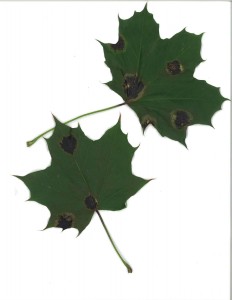Norway maple leaves on the ground in August and early September? Noticing black spots on the green leaves? The Tar Spot fungal disease of Norway maples is prevalent this year.
There are black spots and the leaves are falling. We’re noticing the symptoms now but it all started in the spring as the new young leaves were expanding. At that time of year they can become infected by spores that are released by from spots on last year’s leaves. Those spores can drift via air currents and if they reach a Norway maple leaf and it there’s enough moisture then it will grow inside the leaf. It is a slow process and the first symptoms aren’t noticed until mid summer, but by late summer and early fall we can see the results of those spring time airborne spores.

Leaf drop occurs when the Tar Spot lesion develops on the leaf stem or petiole and cuts off the pipework to the rest of the leaf.
Will this cause my tree to decline? For concerned homeowners the good news is that this disease does not affect the overall health of Norway maples and they will produce a full canopy of leaves again next spring. Will it help to remove the fallen leaves with spots this fall? Yes, somewhat, but since the spores can drift through the air the infection can still take place from airborne spore originating nearby. With the variations in spring moisture from year to year the amount of the disease also varies annually.
Composting is okay! A Cornell study by Dr. George Hudler concluded that the leaves can be composted with no danger of spreading the disease as long as those leaves are not exposed to air at the top of the pile the following spring when they would be releasing their spores.
Although once popularly planted as a landscape tree, the Norway maple has a bad habit of shedding a copious number of seeds each year. The subsequent seedlings have invaded wild forests and crowded out some of our native plant species. In the spring of 2015 they became regulated and now any Norway maple trees sold in NY state must be accompanied by a label with the words “Invasive Species- Harmful to the Environment”.




